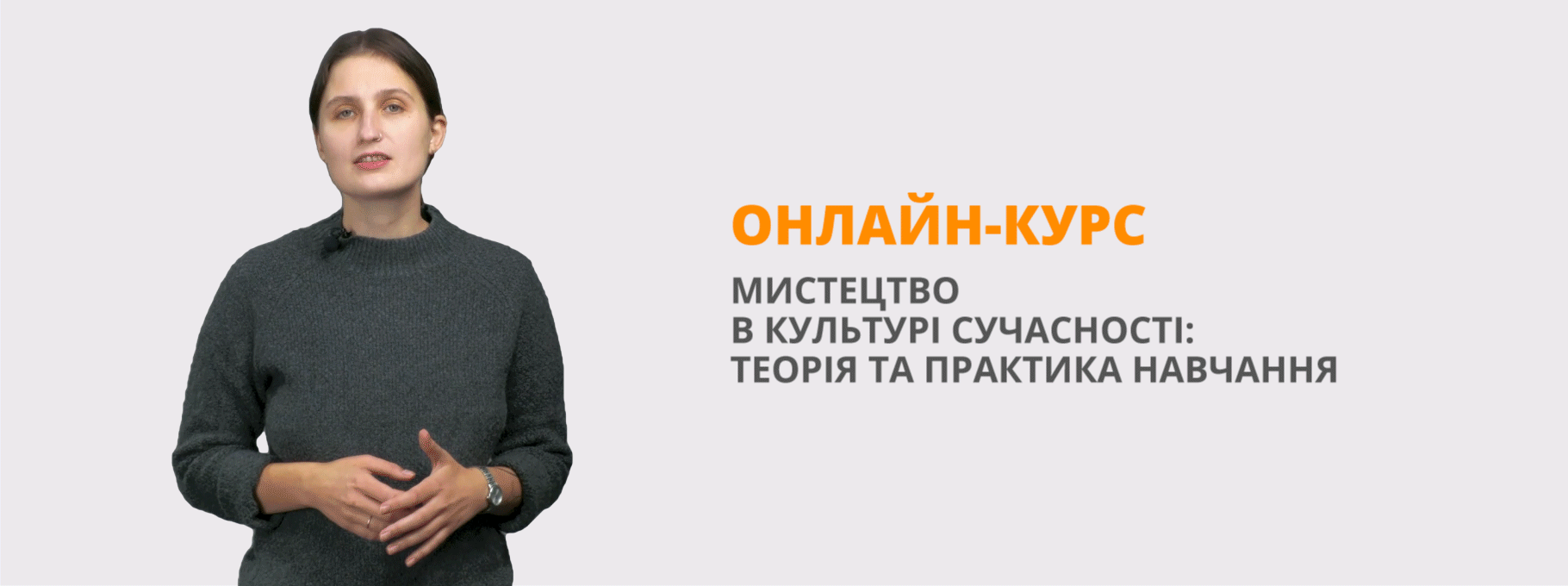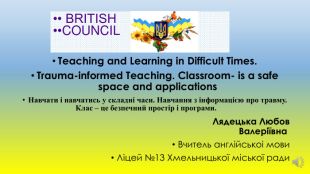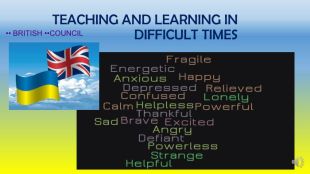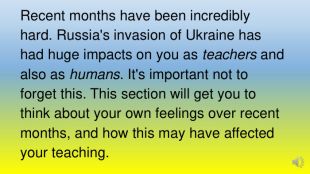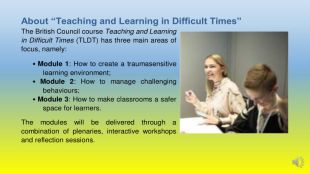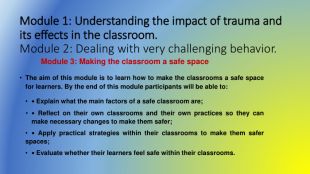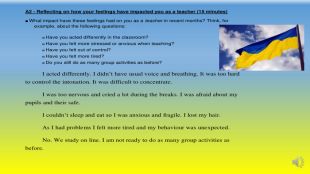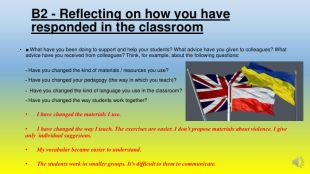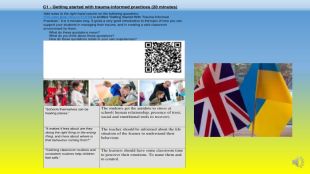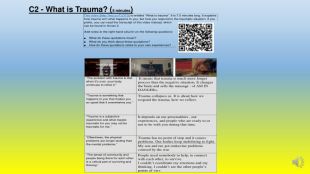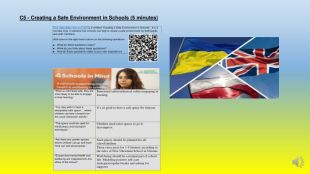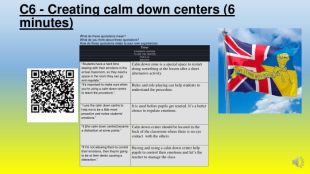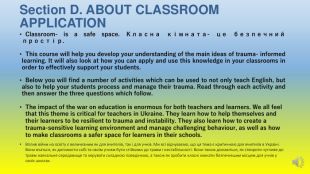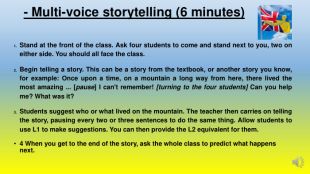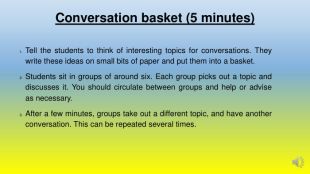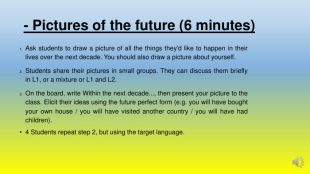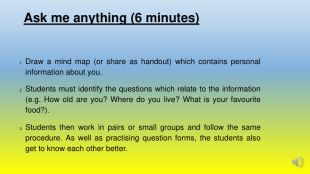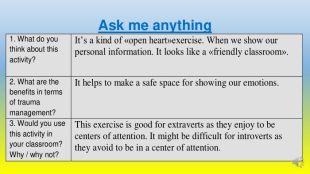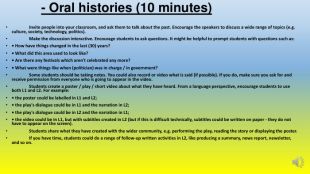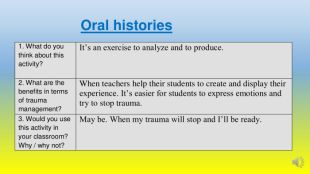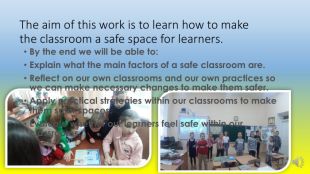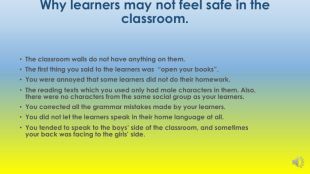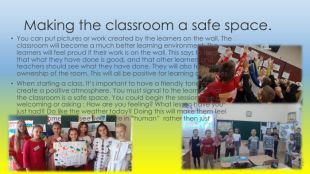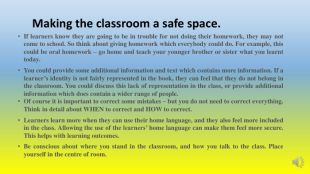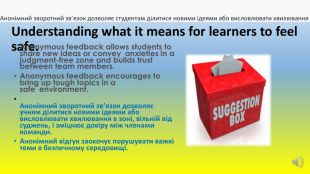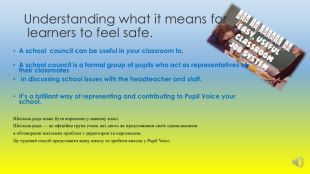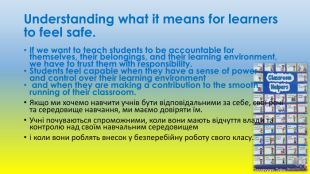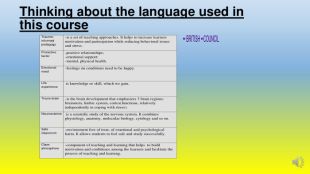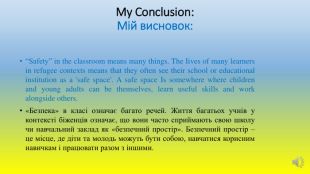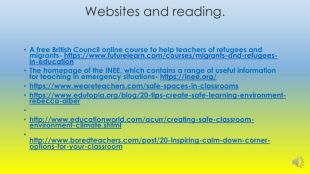презентація "Навчання в важкі часи. Практика British Council"














![- Multi-voice storytelling (6 minutes) Stand at the front of the class. Ask four students to come and stand next to you, two on either side. You should all face the class. Begin telling a story. This can be a story from the textbook, or another story you know, for example: Once upon a time, on a mountain a long way from here, there lived the most amazing ... [pause] I can't remember! [turning to the four students] Can you help me? What was it?Students suggest who or what lived on the mountain. The teacher then carries on telling the story, pausing every two or three sentences to do the same thing. Allow students to use L1 to make suggestions. You can then provide the L2 equivalent for them.4 When you get to the end of the story, ask the whole class to predict what happens next. - Multi-voice storytelling (6 minutes) Stand at the front of the class. Ask four students to come and stand next to you, two on either side. You should all face the class. Begin telling a story. This can be a story from the textbook, or another story you know, for example: Once upon a time, on a mountain a long way from here, there lived the most amazing ... [pause] I can't remember! [turning to the four students] Can you help me? What was it?Students suggest who or what lived on the mountain. The teacher then carries on telling the story, pausing every two or three sentences to do the same thing. Allow students to use L1 to make suggestions. You can then provide the L2 equivalent for them.4 When you get to the end of the story, ask the whole class to predict what happens next.](/uploads/files/2004882/389493/443253_images/15.jpg)




















•• BRITISH ••COUNCILTeaching and Learning in Difficult Times. Trauma-informed Teaching. Classroom- is a safe space and applications. Навчати і навчатись у складні часи. Навчання з інформацією про травму. Клас – це безпечний простір і програми. Лядецька Любов Валеріївна Вчитель англійськоі мови. Ліцей №13 Хмельницької міської ради
Recent months have been incredibly hard. Russia's invasion of Ukraine has had huge impacts on you as teachers and also as humans. It's important not to forget this. This section will get you to think about your own feelings over recent months, and how this may have affected your teaching.
Module 1: Understanding the impact of trauma and its effects in the classroom. Module 2: Dealing with very challenging behavior. Module 3: Making the classroom a safe space. The aim of this module is to learn how to make the classrooms a safe space for learners. By the end of this module participants will be able to:• Explain what the main factors of a safe classroom are;• Reflect on their own classrooms and their own practices so they can make necessary changes to make them safer;• Apply practical strategies within their classrooms to make them safer spaces;• Evaluate whether their learners feel safe within their classrooms.
B2 - Reflecting on how you have responded in the classroom■ What have you been doing to support and help your students? What advice have you given to colleagues? What advice have you received from colleagues? Think, for example, about the following questions:- Have you changed the kind of materials / resources you use?- Have you changed your pedagogy (the way in which you teach)?- Have you changed the kind of language you use in the classroom?- Have you changed the way students work together?I have changed the materials I use. I have changed the way I teach. The exercises are easier. I don’t propose materials about violence. I give only individual suggesions. My vocabular became easier to understand. The students work in smaller groups. It’s difficult to them to communicate.
Section D. ABOUT CLASSROOM APPLICATIONClassroom- is a safe space. Класна кімната- це безпечний простір. This course will help you develop your understanding of the main ideas of trauma- informed learning. It will also look at how you can apply and use this knowledge in your classrooms in order to effectively support your students. Below you will find a number of activities which can be used to not only teach English, but also to help your students process and manage their trauma. Read through each activity and then answer the three questions which follow. The impact of the war on education is enormous for both teachers and learners. We all feel that this theme is critical for teachers in Ukraine. They learn how to help themselves and their learners to be resilient to trauma and instability. They also learn how to create a trauma-sensitive learning environment and manage challenging behaviour, as well as how to make classrooms a safer space for learners in their schools. Вплив війни на освіту є величезним як для вчителів, так і для учнів. Ми всі відчуваємо, що ця тема є критичною для вчителів в Україні. Вони вчаться, як допомогти собі та своїм учням бути стійкими до травм і нестабільності. Вони також дізнаються, як створити чутливе до травм навчальне середовище та керувати складною поведінкою, а також як зробити класні кімнати безпечнішим місцем для учнів у своїх школах.
- Multi-voice storytelling (6 minutes) Stand at the front of the class. Ask four students to come and stand next to you, two on either side. You should all face the class. Begin telling a story. This can be a story from the textbook, or another story you know, for example: Once upon a time, on a mountain a long way from here, there lived the most amazing ... [pause] I can't remember! [turning to the four students] Can you help me? What was it?Students suggest who or what lived on the mountain. The teacher then carries on telling the story, pausing every two or three sentences to do the same thing. Allow students to use L1 to make suggestions. You can then provide the L2 equivalent for them.4 When you get to the end of the story, ask the whole class to predict what happens next.
Conversation basket (5 minutes)Tell the students to think of interesting topics for conversations. They write these ideas on small bits of paper and put them into a basket. Students sit in groups of around six. Each group picks out a topic and discusses it. You should circulate between groups and help or advise as necessary. After a few minutes, groups take out a different topic, and have another conversation. This can be repeated several times.
- Pictures of the future (6 minutes)Ask students to draw a picture of all the things they'd like to happen in their lives over the next decade. You should also draw a picture about yourself. Students share their pictures in small groups. They can discuss them briefly in L1, or a mixture or L1 and L2. On the board, write Within the next decade..., then present your picture to the class. Elicit their ideas using the future perfect form (e.g. you will have bought your own house / you will have visited another country / you will have had children).4 Students repeat step 2, but using the target language.
Ask me anything (6 minutes)Draw a mind map (or share as handout) which contains personal information about you. Students must identify the questions which relate to the information (e.g. How old are you? Where do you live? What is your favourite food?). Students then work in pairs or small groups and follow the same procedure. As well as practising question forms, the students also get to know each other better.
- Oral histories (10 minutes) Invite people into your classroom, and ask them to talk about the past. Encourage the speakers to discuss a wide range of topics (e.g. culture, society, technology, politics). Make the discussion interactive. Encourage students to ask questions. It might be helpful to prompt students with questions such as:• How have things changed in the last (30) years?• What did this area used to look like?• Are there any festivals which aren't celebrated any more?• What were things like when (politician) was in charge / in government? Some students should be taking notes. You could also record or video what is said (if possible). If you do, make sure you ask for and receive permission from everyone who is going to appear in the video. Students create a poster / play / short video about what they have heard. From a language perspective, encourage students to use both L1 and L2. For example:• the poster could be labelled in L1 and L2;• the play's dialogue could be in L1 and the narration in L2;• the play's dialogue could be in L2 and the narration in L1;• the video could be in L1, but with subtitles created in L2 (but if this is difficult technically, subtitles could be written on paper - they do not have to appear on the screen). Students share what they have created with the wider community, e.g. performing the play, reading the story or displaying the poster. If you have time, students could do a range of follow-up written activities in L2, like producing a summary, news report, newsletter, and so on.
The aim of this work is to learn how to make the classroom a safe space for learners. By the end we will be able to: Explain what the main factors of a safe classroom are. Reflect on our own classrooms and our own practices so we can make necessary changes to make them safer. Apply practical strategies within our classrooms to make them safer spaces. Evaluate whether our learners feel safe within our classrooms.
Why learners may not feel safe in the classroom. The classroom walls do not have anything on them. The first thing you said to the learners was “open your books”. You were annoyed that some learners did not do their homework. The reading texts which you used only had male characters in them. Also, there were no characters from the same social group as your learners. You corrected all the grammar mistakes made by your learners. You did not let the learners speak in their home language at all. You tended to speak to the boys’ side of the classroom, and sometimes your back was facing to the girls’ side.
Making the classroom a safe space. You can put pictures or work created by the learners on the wall. The classroom will become a much better learning environment. The learners will feel proud if their work is on the wall. This says to them that what they have done is good, and that other learners and teachers should see what they have done. They will also feel more ownership of the room. This will all be positive for learning outcomes. When starting a class. It’s important to have a friendly tone and create a positive atmosphere. You must signal to the learners that the classroom is a safe space. You could begin the session by e.g. welcoming or asking : How are you feeling? What lesson have you just had? Do like the weather today? Doing this will make them feel more at home, and see you more in “human” rather then just “teacher” terms.
Making the classroom a safe space. If learners know they are going to be in trouble for not doing their homework, they may not come to school. So think about giving homework which everybody could do. For example, this could be oral homework – go home and teach your younger brother or sister what you learnt today. You could provide some additional information and text which contains more information. If a learner’s identity is not fairly represented in the book, they can feel that they do not belong in the classroom. You could discuss this lack of representation in the class, or provide additional information which does contain a wider range of people. Of course it is important to correct some mistakes – but you do not need to correct everything. Think in detail about WHEN to correct and HOW to correct. Learners learn more when they can use their home language, and they also feel more included in the class. Allowing the use of the learners’ home language can make them feel more secure. This helps with learning outcomes. Be conscious about where you stand in the classroom, and how you talk to the class. Place yourself in the centre of room.
Understanding what it means for learners to feel safe. A blob tree can be useful in your classroom. This test helps us to recognize and strengthen emotions, and to some extent, understand students’ social status in society too. Each blob figure in this picture is in a different mood and has a different position on the tree.
Understanding what it means for learners to feel safe. Anonymous feedback allows students to share new ideas or convey anxieties in a judgment-free zone and builds trust between team members. Anonymous feedback encourages to bring up tough topics in a safe environment. Анонімний зворотний зв’язок дозволяє учням ділитися новими ідеями або висловлювати хвилювання в зоні, вільній від суджень, і зміцнює довіру між членами команди. Анонімний відгук заохочує порушувати важкі теми в безпечному середовищі. Анонімний зворотний зв’язок дозволяє студентам ділитися новими ідеями або висловлювати хвилювання в зоні, вільній від суджень, і зміцнює довіру між членами команди. Анонімний відгук заохочує порушувати важкі теми в безпечному середовищі.
Understanding what it means for learners to feel safe. A school council can be useful in your classroom to. A school council is a formal group of pupils who act as representatives of their classmates in discussing school issues with the headteacher and staff. It’s a brilliant way of representing and contributing to Pupil Voice your school. Шкільна рада може бути корисною у вашому класі. Шкільна рада — це офіційна група учнів, які діють як представники своїх однокласниківв обговоренні шкільних проблем з директором та персоналом. Це чудовий спосіб представити вашу школу та зробити внесок у Pupil Voice.
Understanding what it means for learners to feel safe. If we want to teach students to be accountable for themselves, their belongings, and their learning environment, we have to trust them with responsibility. Students feel capable when they have a sense of power and control over their learning environment and when they are making a contribution to the smooth running of their classroom. Якщо ми хочемо навчити учнів бути відповідальними за себе, свої речі та середовище навчання, ми маємо довіряти їм. Учні почуваються спроможними, коли вони мають відчуття влади та контролю над своїм навчальним середовищемі коли вони роблять внесок у безперебійну роботу свого класу.
Understanding what it means for learners to feel safe. EXIT ACTIVITYWhy not use the end of class for an exit ticket or activity? Consider more specific options like Brain Dumps, Goals & Reflections, SEL Check-in, Reading Ladder, Skill Reinforcement (Use your end-of-class exit activity as a formative assessment opportunity. Did you teach a grammar lesson? … a new vocabulary word? … a writing skill? … a reading strategy? Ask a question that will give you the data you need to direct the next lesson). ВИХІД ДІЯЛЬНОСТІЧому б не використати кінець уроку для квитка на вихід або діяльності? Розгляньте більш конкретні варіанти, як-от Brain Dumps, Goals & Reflections, SEL Check-in, Reading Ladder, Skill Reinforcement (Використовуйте свою вправу наприкінці уроку як можливість формувального оцінювання. Ви проводили урок граматики? … нове словникове слово ?... навичка письма?... стратегія читання? Поставте запитання, яке дасть вам інформацію, необхідну для наступного уроку).
My Conclusion: Мій висновок:“Safety” in the classroom means many things. The Iives of many learners in refugee contexts means that they often see their school or educational institution as a 'safe space'. A safe space Is somewhere where children and young adults can be themselves, learn useful skills and work alongside others. «Безпека» в класі означає багато речей. Життя багатьох учнів у контексті біженців означає, що вони часто сприймають свою школу чи навчальний заклад як «безпечний простір». Безпечний простір – це місце, де діти та молодь можуть бути собою, навчатися корисним навичкам і працювати разом з іншими.
Websites and reading. A free British Council online course to help teachers of refugees and migrants- https://www.futurelearn.com/courses/migrants-and-refugees-in-education. The homepage of the INEE, which contains a range of useful information for teaching in emergency situations- https://inee.org/https://www.weareteachers.com/safe-spaces-in-classroomshttps://www.edutopia.org/blog/20-tips-create-safe-learning-environment-rebecca-alber http://www.educationworld.com/acurr/creating-safe-classroom-environment-climate.shtmlhttp://www.boredteachers.com/post/20-inspiring-calm-down-corner-options-for-your-classroom
-
 Плетяна Ольга Григорівна 22.01.2024 в 21:23Загальна:3.0Структурованість3.0Оригінальність викладу3.0Відповідність темі3.0
Плетяна Ольга Григорівна 22.01.2024 в 21:23Загальна:3.0Структурованість3.0Оригінальність викладу3.0Відповідність темі3.0
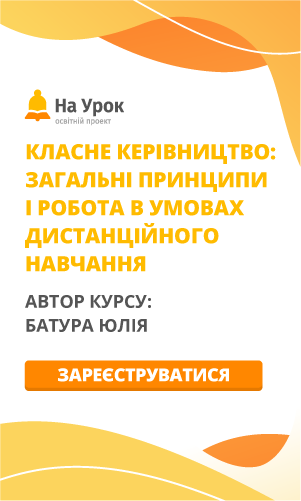

про публікацію авторської розробки
Додати розробку
